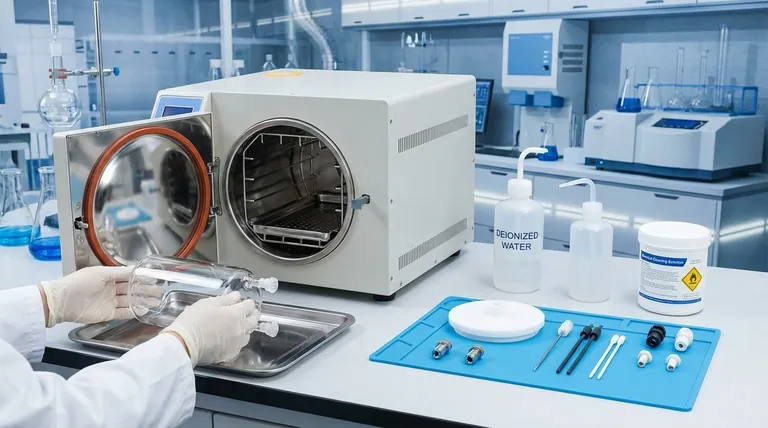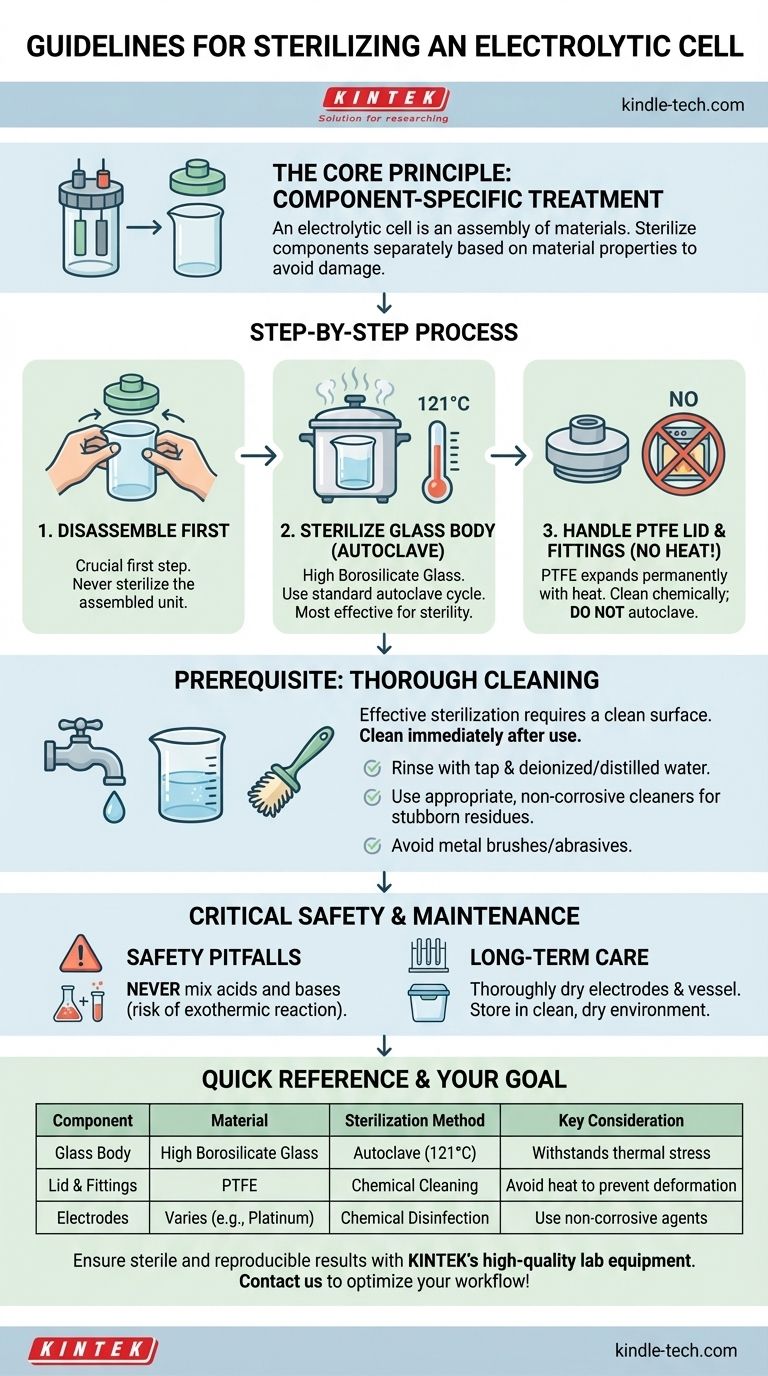To properly sterilize an electrolytic cell, you must first disassemble it. The high borosilicate glass body can be safely sterilized in an autoclave, but the Polytetrafluoroethylene (PTFE) lid cannot be heated, as it will expand and deform permanently. Therefore, the components must be sterilized separately using methods appropriate for each material.
The central challenge of sterilizing an electrolytic cell is not the sterilization itself, but the fact that the cell is an assembly of different materials with different tolerances. The key is to separate the components, sterilizing the heat-resistant glass via autoclave and relying on thorough chemical cleaning for heat-sensitive parts like the lid.

The Core Principle: Component-Specific Treatment
An electrolytic cell is a system of parts, not a single object. Attempting to sterilize the entire assembled unit will inevitably lead to damage. The correct approach requires treating each component according to its material properties.
Sterilizing the Glass Body
The main body of the cell is typically made from high borosilicate glass, which is designed to withstand thermal stress.
This component can and should be sterilized using a standard autoclave cycle, typically at 121°C under high pressure. This is the most effective method for ensuring the glass vessel is truly sterile.
Handling the PTFE Lid and Fittings
The Polytetrafluoroethylene (PTFE) lid is the most common point of failure when sterilizing. It has a high coefficient of thermal expansion.
When heated, a PTFE lid will expand and is unlikely to return to its original shape and size. This will destroy its ability to create a proper seal, rendering the cell unusable. Never place the PTFE lid in an autoclave or oven. Sterilization for this part must be achieved through chemical means after a thorough cleaning.
A Prerequisite to Sterilization: Thorough Cleaning
Effective sterilization is impossible on a dirty surface. A rigorous cleaning protocol is the most critical step in cell maintenance and preparation. Cleaning should be performed immediately after every experiment to prevent residues from hardening.
The Standard Cleaning Protocol
For routine cleaning, first rinse all parts thoroughly with tap water to remove the bulk of the electrolyte and reaction products.
Follow this with multiple, generous rinses using deionized or distilled water. This removes any remaining ions and ensures no residue is left behind.
Tackling Stubborn Residues
If simple rinsing doesn't work, an appropriate cleaning agent can be used. The choice of cleaner depends entirely on the residue you are trying to remove.
Crucially, you must select a cleaning agent that will not corrode the electrodes or damage the cell materials.
Advanced Chemical Cleaning
For stubborn deposits like metal oxides (e.g., rust), a more targeted chemical cleaning is necessary.
For example, dilute hydrochloric acid can effectively remove iron oxides. When performing a chemical clean, you must carefully control the concentration of the reagent and the duration of the exposure to avoid damaging the cell. Afterward, the cell must be rinsed extensively with deionized water until all chemical residue is gone.
Critical Safety Rules and Pitfalls to Avoid
Improper cleaning and handling can permanently damage your equipment or create hazardous situations. Following these rules is non-negotiable.
The Risk of Physical Damage
Never use metal brushes or other hard, abrasive tools to clean any part of the cell. These will create scratches on the glass and electrode surfaces, which can compromise experimental results and create sites for contamination to build up.
The Danger of Chemical Reactions
During cleaning, never mix acids and bases (for example, nitric acid and sodium hydroxide). This will trigger a strong and potentially dangerous exothermic reaction, which can cause injury and damage the cell.
Proper Maintenance for Long-Term Integrity
Once cleaned and sterilized, correct storage is essential for maintaining the cell's condition between uses.
The Importance of Drying
After the final rinse, the electrodes and reaction vessel must be thoroughly dried. Any remaining moisture can lead to corrosion or provide a vector for contamination.
Correct Storage Procedures
Store the cell in a clean, dry environment. If the cell will not be used for an extended period, ensure the electrolyte is completely removed and the cell is sealed or covered to protect it from dust and moisture.
Making the Right Choice for Your Goal
Your specific workflow will determine your focus. Use these guidelines to tailor the process to your needs.
- If your primary focus is routine electrochemical experiments: Your priority is a consistent cleaning protocol. Implement a strict post-use rinse-and-dry procedure immediately after every run to prevent residue buildup and ensure reproducibility.
- If your primary focus is working under sterile conditions (e.g., bio-electrochemistry): You must disassemble the cell for sterilization. Autoclave the glass body, and rely on thorough chemical cleaning and disinfection for the PTFE lid, electrodes, and other non-autoclavable components.
Proper maintenance is the foundation of reliable and accurate electrochemical data.
Summary Table:
| Component | Material | Sterilization Method | Key Consideration |
|---|---|---|---|
| Glass Body | High Borosilicate Glass | Autoclave (121°C) | Withstands thermal stress |
| Lid & Fittings | PTFE (Polytetrafluoroethylene) | Chemical Cleaning | Avoid heat to prevent deformation |
| Electrodes | Varies (e.g., Platinum) | Chemical Disinfection | Use non-corrosive agents |
Ensure your electrochemical experiments are sterile and reproducible with the right equipment and protocols. KINTEK specializes in high-quality lab equipment, including durable electrolytic cells made from autoclavable glass and chemically resistant materials. Our experts can help you select the right tools and establish maintenance routines for accurate, contamination-free results. Contact us today to discuss your laboratory needs and optimize your workflow!
Visual Guide

Related Products
- Desktop Fast Laboratory Autoclave Sterilizer 35L 50L 90L for Lab Use
- PTFE Electrolytic Cell Electrochemical Cell Corrosion-Resistant Sealed and Non-Sealed
- H-Type Double-Layer Optical Electrolytic Electrochemical Cell with Water Bath
- Laboratory High Pressure Steam Sterilizer Vertical Autoclave for Lab Department
- H Type Electrolytic Cell Triple Electrochemical Cell
People Also Ask
- What is an autoclave used for in a lab? Achieve Total Sterilization for Lab Safety and Integrity
- What autoclave is used for sterilization? The Definitive Guide to Steam Sterilization
- What is an autoclave laboratory equipment? The Ultimate Guide to Steam Sterilization
- What should be autoclaved in a lab? A Guide to Safe and Effective Sterilization
- How do you autoclave lab equipment? A Step-by-Step Guide to Sterile Results



















